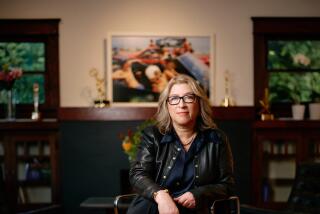‘Bug’ Has the Teen Reality That WB Left Up a ‘Creek’
- Share via
A tale of two cabins . . . and two TV series.
Just think of it: Campfires, swimming, canoeing, sailing, water skiing, archery, Frisbee, arts and crafts and teenagers who--unlike the surreal, nubile, zitless 15-year-olds of WB’s “Dawson’s Creek”--haven’t the sensibilities, perceptions and verbal dexterity of adolescent sophisticates invented by fantasizing Hollywood TV writers.
You’ll find this bracing realism on the 18-part “Bug Juice,” a fun and refreshingly natural documentary series about summer campers opening Saturday on the Disney Channel.
Observing their unrehearsed, unscripted routine is seductive and a real kick. Ranging in age mostly from 13 to 15, the youths here sometimes flirt, sometimes bicker, sometimes are silly, sometimes are mature. Like typical teens, they tend toward the mercurial, inflating small dilemmas into throbbing crises, then just as swiftly resolving them on their own. In other words, they co-exist, have fun and learn about themselves away from home while acting their ages.
Has co-creator Douglas Ross, himself a 36-year-old former summer camper, seen such teens on TV previously?
“I don’t think I have,” Ross said this week. “When I see kids portrayed on television, they are very cartoonish . . . playing out the stereotypes that adults think they are.”
Meet the exceptions, and not by chance. Last summer, Ross and co-creator J. Rupert Thompson deployed three camera crews and other production staff at 75-year-old Camp Waziyatah, 150 acres of rustic fun in Waterford, Maine, owned by a friend of Thompson’s and encompassing a blue lake as tranquil and picturesque as the one in the deadly “Friday the 13th” films. This time, however, the only Jason in sight is a lanky 15-year-old camper from New York who, unlike the loopy, indestructible killer of that name in the movies, wears no hockey mask and actually speaks, saying he prefers camp to home because “you can be goofy and be yourself and things like that.”
It takes preparation to capture “things like that” on videotape, however. So the show’s commanders revamped the camp’s lighting and electrical circuits, added telephone and fax lines, hired family therapists to instruct the crews on what to expect from the kids and planned meticulously. Then for 56 days, they shot 1,000 hours of tape chronicling the daily experiences and personal interactions of nine boy and nine girl campers whose backgrounds ranged from upscale Westport, Conn., to Brooklyn’s inner city.
The rewarding result is “Bug Juice”--the title is a nickname for the soft drink served campers--a chunk of television somewhat similar to the quasi-documentary series “The Real World” on MTV, a major difference being that, unlike the latter’s adult participants, the kids of this new series were not recruited specifically for this enterprise. All of them, including three having their $4,000 tuition paid on scholarship, were coming to camp anyway.
Ross says that the only conscious shaping of reality he and his colleagues did was slight, joining with Waziyatah owners in choosing which campers would occupy the two cabins--one per gender. These youths would become the focus of “Bug Juice.”
The series affirms just how entertaining the routine of someone else’s life can be when skillfully edited into a narrative.
This one consists of dialogue among the campers and their counselors, who sometimes wore mikes, interspersed with occasional brief interviews with them to fill in some gaps. The kids always had the option of saying no to the camera.
“We told the camp we would never tell the campers to do something, never give them any kind of direction or tell them to do something again,” Ross said. “If we missed something, we missed it.”
There was direction, though: Viewing everything through tiny hand-held monitors from various spots away from the action were the show’s directors--a male for the boys and a female for the girls--who, in typical TV procedure, communicated with the camera operators via headsets so they could give them guidance without interfering or being overheard.
“For example, the camera might be shooting a dance contest, but maybe the most important part of the story was the kids who weren’t participating,” said Ross. “So the director outside could say, ‘Slowly pan right, ‘cause Jason is having a conversation with Alison. What is that about?’ ”
Although a TV camera’s presence inevitably influences reality to some extent, the amazing thing about “Bug Juice” is the candor of the campers and how oblivious they seemingly are to the lens so often shadowing them.
“Even though these kids are articulate, worldly and in many ways mature, beneath it all they were regular kids with regular concerns,” said Ross. “And that was very refreshing.”
So we learn that Asa, 12, and Malik, 13, feel like outsiders because they’re younger than the others. We see Caitlin, 15, get so upset about the planning of a campfire event that she makes an emotional phone call to her mother and pleads to come home. And we see the eternal boy-girl thing: 14-year-old Kisha and 13-year-old Jenny, her braces framed by painted crimson lips, clashing over that irresistible baldy, Hassan, 14. And 14-year-olds Sarai and Stephanie (“I’m boy crazy, OK?”) having it out over that handsome hunk, Connor, 14, only to have an emotional rapprochement by themselves and end their rivalry with a teary embrace.
“Bug Juice” is no sultry hothouse. “Yes, they had crushes on each other, which is part of the camp experience,” said Ross. “But other than hand-holding and a couple of first kisses--and I’m talking about pecking kind of kisses--that’s about it.”
If this were “Dawson’s Creek,” the campers would be having open debates about boobs and genitalia, and getting it on with their counselors.
When we last checked in with the 15-year-olds on that increasingly popular show, Dawson’s precocious sophomore pal, Pacey, was having a secret affair with his gorgeous 36-year-old English teacher, Tamara Jacobs, which the series was treating almost whimsically. And responding to criticism of this romanticized plot line, WB executives were vowing that Tamara would be made to pay in a future episode for her felonious sleeping with a minor.
That episode came Tuesday when, after Pacey was overheard mentioning the affair to Dawson, rumors abounded, and Tamara berated Pacey for “opening up your big mouth.” When she was summoned before the school board to answer yea or nay, however, Pacey burst in before she could reply and did the gallant thing by contending that he had made up the story.
The school board, flaunting its collective IQ of 10, bought Pacey’s lie, allowing the criminally ill Tamara to avoid the kind of recriminations and messy trial that ultimately sent a recent real-life counterpart, Mary Kay LeTouorneau, to prison in Washington.
Her reputation still intact, Tamara then took the high road and resigned her teaching job en route to leaving town, finding an adult to love and maybe having children, “if it’s not too late.” Sob.
After a teary farewell with Pacey on her housesteps and a final embrace, this very sick woman was allowed by the series to ride off into the sunset as a sympathetic character on a very high horse, with the resilient Pacey seemingly none the worse for wear.
Justice, “Dawson’s Creek” style.
*
* The first two episodes of “Bug Juice” begin Saturday at 8:30 p.m. and both repeat Sunday at 5 p.m. on cable’s Disney Channel. Thereafter, new episodes are scheduled for Sundays at 5 p.m., with repeats the following Saturday at 5 p.m. The network has rated it TV-G (suitable for all ages).
More to Read
The complete guide to home viewing
Get Screen Gab for everything about the TV shows and streaming movies everyone’s talking about.
You may occasionally receive promotional content from the Los Angeles Times.






